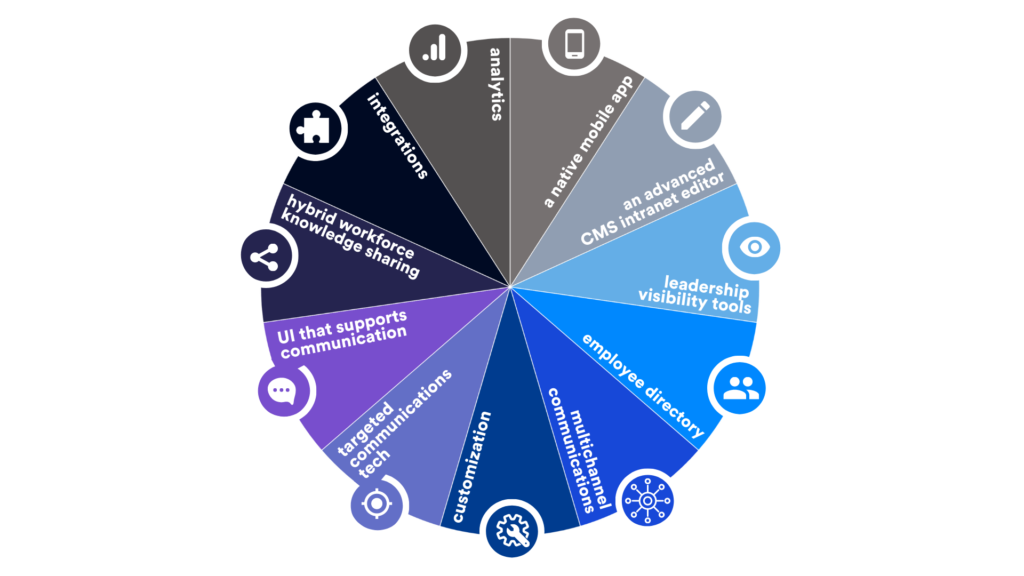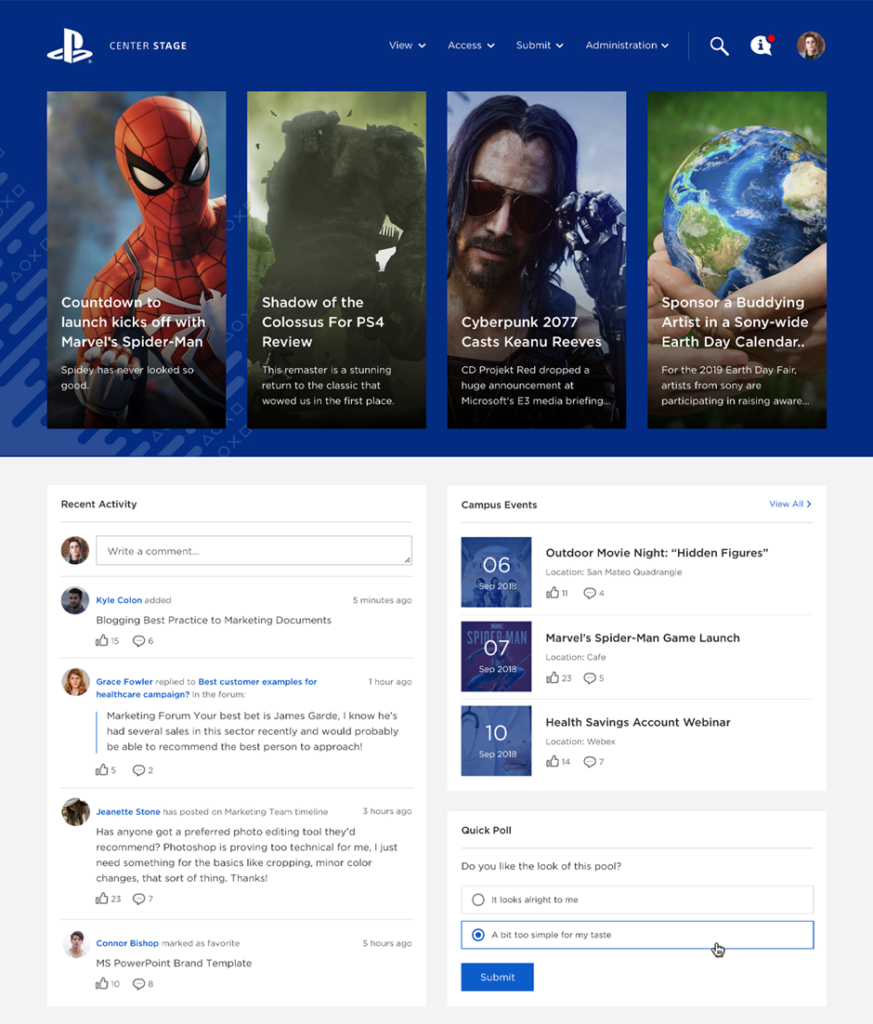Many organizations achieved stability in 2021, but unpredictability has re-emerged as a major theme heading into 2022. With this in mind, collaboration and communications tools that enable the hybrid workforce to function look set to stay. If you’re planning your 2022 communications strategy, make sure you have access to these essential digital workplace tools.
Of all the changes accelerated by the global pandemic, the emergence of remote and hybrid workforce models may be one that stands the test of time. Many employees are keen to retain the flexibility that technologies have supported so far, but fully remote work may not yet be the solution.
According to a recent Google survey on the hybrid workforce in 2021, 75% of those surveyed believed that hybrid working will become standard practice in the next three years, but only 70% had operated remotely before the pandemic. Limited experience and infrastructure—including poor internet connections for many—may mean that the transition to fully remote work will take longer and involve a hybrid transition phase that mixes on-location/in-office working with remote.
In addition to organizational and individual needs, the pandemic is also still causing significant disruption to the idea of returning to offices full-time. The recent emergence of the Omicron coronavirus variant is just one example of how the ongoing crisis can suddenly disrupt travel, work, and personal arrangements. For the time being, videoconferencing, cloud-based collaboration tools, and intranet software will continue to support hybrid working and the communicators who need to reach dispersed groups. Below, we round up some of the digital workplace tools that will be essential for communicating with a hybrid workforce in 2022.
14 steps to creating an effective comms strategy
Tools for the hybrid workforce: a general update
When organizations began the transition to remote and hybrid working, there was some debate about which tools would be most helpful for internal communications and workplace collaboration.
However, a recent survey of HR, IT, and Comms leaders by CMSWire suggested that with several months of the “new normal” now behind us, businesses recognize the need for tools which go beyond “siloed, generic digital environments”. The same respondents pointed to modern intranet software as a key part of their ability to engage hybrid workforces. 60% of those surveyed believed that a modern intranet could produce increased employee engagement.
The intranet features these leaders considered most important were:
- Customized and personalized homepages
- Software integrations with leading providers (e.g., SharePoint, Salesforce)
- Enterprise search
- An easy-to-use interface
- Analytics
- Mobile-enabled
We consider these, and more, in our 2022 roundup of essential digital workplace technologies.

1. A native mobile app
A hybrid workforce is characterized not just by location, but also by a need to access content flexibly, including via mobile phone. In addition to a responsive web experience, a dedicated mobile app is an extra tool allowing all employees to access the intranet securely and to receive communications via messages and push notifications.
2. An advanced CMS intranet editor
As we adjust to hybrid working, we also need to think about how we bring dispersed employees together through the publication of appealing content. If you want to engage people even when they’re away from the office then a content management system that enables the distribution of video, graphics, and images may be helpful. Consumer surveys suggest that 66% of people prefer to watch a video when learning about a new product or service (compared to 18% who prefer a text-based medium). If you can’t give in-office workers live demos or updates, perhaps video is the answer.
3. Leadership visibility tools
To keep people engaged and informed when their attention is split between home and the office, a hybrid workforce requires clear communications. This can be helped by enhancing senior leader visibility. Create a dedicated space on the intranet homepage so senior leaders can post business updates (but potentially even about their own hybrid working arrangements too). Updates may include blogs, vlogs, and timeline posts, and they don’t all have to be lengthy endeavors.
14 steps to creating an effective comms strategy
4. Employee directory
As it’s now become nearly impossible to physically meet with every co-worker, a searchable employee directory that carries mini-bios and contact details for employees can help. By asking users to add their skills, interests, and experience to their profiles, dispersed workers can connect and communicate. For communicators too, having access to this people library may be invaluable when you need to conduct social listening exercises that paint a rounded picture of the audiences you’re trying to reach.
5. Multichannel communications
A crisis has the potential to arrive at any time. Whether you need to confirm staff safety, execute emergency protocols, or distribute business continuity plans, a centralized hub can help you to issue crisis comms through a multichannel network. Rather than waiting for people to pick up emails, it’s now possible to get urgent messages read faster through a combination of SMS, mobile app notification, homepage banners, email, and Slack/Teams messages. This approach ensures that a hybrid workforce stays informed wherever they are.
6. Hybrid workforce knowledge sharing
When colleagues are dispersed (around the world in many cases), it’s important to ensure that knowledge circulates in a way that benefits everyone. Many of our customers use intranet forums to create environments for employees—regardless of where they are—to ask questions or start discussions.
If you’re building a 2022 communications strategy, it’s important not to overlook the mutual reinforcement and sharing of content that takes place between colleagues. Creating a culture of open communication and knowledge sharing can help energize comms campaigns too.
14 steps to creating an effective comms strategy
7. Targeted communications tech
Traditional organization-wide user groupings have limitations when it comes to effective communications. Creating email distribution groups is the default mode for getting information out, but these are difficult to maintain and cause information siloes. By creating personas within your intranet, you can set up and then target dynamic groups based on important hybrid workforce variations such as location (assuming you collate the necessary metadata). Targeted communications help to direct messages to the right people and result in more impactful internal communications.
8. Analytics
The arrival of hybrid working is another event which shows the value of employee analytics tools. Most modern intranet software offers analytics that measure everything from the clicks on a page to the most searched for keywords. This data allows communicators to make strategic decisions based on real-time information. In the case of a hybrid workforce, we might consider whether content is performing differently than it did with an in-office user base. If so, why might this be and what should you do to change how comms are received? These analytics insights can start further investigations into how well employee communications are performing.
9. Customization
If employees feel like they’re having a generic, unloved experience then they’re unlikely to truly engage with it – especially if they’re already distant from the office environment. Customized intranet homepages can work in two ways to make dispersed workers feel part of something. First, intranet software branded in line with house styles can generate a sense of belonging through design.

Secondly, homepages tailored to specific employee groups can create the more targeted experience that the business leaders in the CMSWire survey mentioned above now demand. Software can allow communicators to choose who to target (according to attributes such as department, brand, location, or persona) and then give each homepage individual look and content.
10. Integrations
A hybrid workforce relies on its employer to provide a digital experience with minimal friction and a significant set of integrations between collaboration, communication, and content platforms. An intranet should sit alongside existing business suite software so that it’s easy to move from speaking with Marketing to accessing documents hosted by HR. Integrations with Google Workspace, Microsoft365, and others are standard, but links to Salesforce, Dropbox, Workday, and other products that suit individual organizations will continue to be crucial in 2022.
11. UI that supports communication
Push communications such as email will continue to be important, but technologies that encourage users to ‘pull’ content towards them (e.g. digital signage) also have a key place in comms plans. Getting people to pull content, however, relies on creating an easy-to-use user interface (UI) that admins and readers alike find enjoyable. An intranet offering an intuitive, easily learned experience is more likely to get greater employee engagement and unite workers in different locations.
If organizations can marshal the best aspects of both home and office working, the hybrid workforce is likely to thrive. With no requirement to house static desks and an increased awareness of their carbon footprint, organizations are likely to downsize their physical estates and put more resources into technology that connects individuals with the whole.
This may prove to be positive for HR and communicators because the ability to increase employee engagement and create a positive employee experience has been enhanced in recent years by technologies that adapt popular features for the workplace. The use of social media tools such as liking, commenting, @mentioning, for example, along with the development of rich-media CMS intranets, have all contributed to exciting new directions in the digital workplace. It seems likely that any increased focus and investment as a result of the switch to hybrid working will make these developments even more engaging and widespread.


